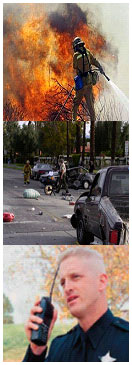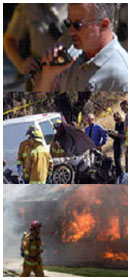Public Safety Enterprise Communication System
Working together for the safety of Riverside County

PSEC is a cooperative effort between multiple departments. The primary goals of these departments are to address the safety issues for first responders:
- Ease of use
- Reliability
- Increased coverage
- Continuous Training
- Interoperability


Answering the Challenge
The county’s public safety radio network is aging and cannot reach some of our newest neighborhoods. Today, county firefighters and law-enforcement officers use the radio more than ever to talk and send data. The new system will expand coverage and build radio links to other agencies that will help protect the public and our safety officers.
Project Summary and Objectives
The County of Riverside currently operates an 800 MHz radio system that is lacking in coverage and functionality. The current system has a reduced level of interoperability.
The County of Riverside’s fire and law enforcement agencies currently utilizes approximately 20 communication sites to provide voice and data transmission capabilities to assigned personnel in the field. As currently configured, the system provides coverage to only about 60 percent of the County. The communication system now in use is at the end of its useful life, and is no longer adequate to meet the County’s coverage and capacity needs. Population growth within the County is necessitating the expansion of the coverage footprint. Additionally, due to increases in the County’s radio usage, additional traffic-carrying capacity is required to meet the needs of emergency services personnel to serve the public.
The Public Safety Enterprise Communication project is the expansion of the systems capabilities and its associated infrastructure. The new system is urgently needed to ensure the safety of the public, Sheriff’s deputies and firefighters.
When Your Community’s Resources are Already Stretched to the Limit
 Your public safety agencies are being asked to shoulder greater responsibilities at a time when budgets are tight. Security is a high priority, but it’s not the only demand on your local government and its taxpayers. How can you strike a balance while promoting the safety of your citizens? One answer is to leverage the resources of neighboring communities. In Southern California and across the country, police, fire, EMS, local government and other related departments are learning to work together. Close cooperation allows for more efficient handling of everyday incidents such as region-wide abduction alerts and pursuits that cross municipal borders.
Your public safety agencies are being asked to shoulder greater responsibilities at a time when budgets are tight. Security is a high priority, but it’s not the only demand on your local government and its taxpayers. How can you strike a balance while promoting the safety of your citizens? One answer is to leverage the resources of neighboring communities. In Southern California and across the country, police, fire, EMS, local government and other related departments are learning to work together. Close cooperation allows for more efficient handling of everyday incidents such as region-wide abduction alerts and pursuits that cross municipal borders.
Are your radio networks ready for a large-scale incident?
 As if earthquakes, floods, mudslides and fires were not enough, you can add terrorist incidents to the list of events that could require your departments to coordinate a joint response with other jurisdictions at a moment's notice. The key is to establish and address both day to day operations and
Interoperability with PSEC cities and existing and future regional networks.
As if earthquakes, floods, mudslides and fires were not enough, you can add terrorist incidents to the list of events that could require your departments to coordinate a joint response with other jurisdictions at a moment's notice. The key is to establish and address both day to day operations and
Interoperability with PSEC cities and existing and future regional networks.
Interoperable Radio is Vital in Daily Emergencies
Our region is vulnerable. Most of the public safety networks now operating within
Riverside County function as islands. When a unit from one city leaves its
home jurisdiction, radio contact diminishes rapidly. Smaller cities often have no
wide-area coverage. Sometimes different departments in the same
city are out of contact. It can be difficult and slow to establish interagency communications-a
hindrance for normal operations and potentially fatal for disaster response.
We can eliminate this weakness with an interoperable network that supports seamless
communications across departments and communities. Citizens who call for help
could get a response from the closest vehicle, even if it's from a different agency. Front-line
officers in trouble could get help faster and warn others to minimize exposure to high risk situations.
Rescuers could establish direct radio contact while their commanders coordinate activities and
planning. Interoperability is crucial. That's why our region is developing PSEC.
